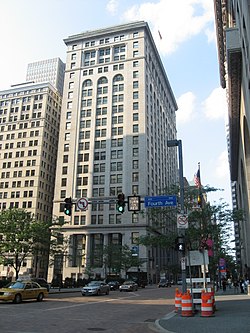Frick Building
| Frick Building | |
|---|---|

View of the Frick Building along Grant Street
|
|
| General information | |
| Type | Office |
| Location | 437 Grant Street, Pittsburgh, Pennsylvania |
| Coordinates | 40°26′21″N 79°59′51″W / 40.43917°N 79.99750°WCoordinates: 40°26′21″N 79°59′51″W / 40.43917°N 79.99750°W |
| Construction started | 1901 |
| Completed | March 15, 1902 |
| Opening | March 15, 1902 |
| Cost | $2 million ($57.6 million today) |
| Height | |
| Roof | 330 ft (101 m) |
| Technical details | |
| Floor count | 20 |
| Floor area | 357,474 sq ft (33,210 m2) |
| Lifts/elevators | 11 |
| Design and construction | |
| Architect | D. H. Burnham & Company |
| Developer | Henry Clay Frick |
| Main contractor | George A. Fuller Company |
| Designated | 1974 |
The Frick Building is one of the major distinctive and recognizable features of Downtown Pittsburgh, Pennsylvania, United States. The tower was built by and is named for Henry Clay Frick, an industrialist coke producer who created a portfolio of commercial buildings in Pittsburgh. The building is listed on the National Register of Historic Places.
The tower was built directly adjacent to a building owned by his business partner and rival Andrew Carnegie, on the site of Saint Peter Episcopal Church. Frick, who feuded with Carnegie after they split as business associates, had the building designed to be taller than Carnegie's in order to encompass it in constant shadow.
The Frick Building was opened on March 15, 1902 and originally had twenty floors. It was the tallest building in the city at that time. A leveling of the surrounding landscape that was completed in 1912 caused the basement to become the entrance, so some sources credit the building with twenty-one stories. It rises 330 feet (101 m) above Downtown Pittsburgh. Its address is 437 Grant Street, and is also accessible from Forbes and Fifth Avenues.
The building's architect was Daniel H. Burnham of D.H. Burnham & Company, Chicago.
The top floor includes a balcony around the perimeter of the building, a high, handcrafted ceiling, and heavy, elaborate brass door fixtures. Originally, H.C. Frick used it as his personal office and as a meeting place and social club for wealthy industrialists. On the 19th floor was Frick's personal shower. At the time, no other shower had been built that high above ground level, because water could not easily be pumped that high with the technology of the time. The shower, non-functioning, still exists on the 19th floor today. The 20th and part of the 19th floors are now used as offices for Carnegie Learning. The width is 1,083 ft.
...
Wikipedia
